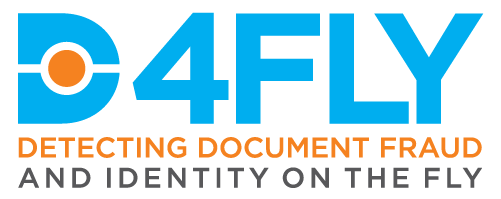D4FLY Multimodal Biometric Dataset
The D4FLY Multimodal Biometric Dataset has been created based on a data capture event that took place at the premises of the University of Reading in October 2020. D4FLY consortium partners from UREAD, NTNU, VD, TRI and WAT participated in this event either in person or remotely (due to the COVID-19 pandemic).
In the current dataset, six types of biometrics are included: 3D face, thermal face, iris on-the-move, iris mobile, somatotype, smartphone sensors.
3D face: captured using an innovative Raytrix R26 monochromatic imaging sensor with a ZEISS Interlock 2/135 lens. Both a static and walking scenario for each subject was captured. 3D point cloud of each sample is provided
Thermal face: captured using a FLIR A65 thermal camera with an image resolution of 640×512 pixels. The thermal face images were captured while the person was on-the-move walking in a straight line towards the camera at 30 frames per second.
Iris on-the-move: captured using two different iris sensors: IrisID OU75 for enrolment and Raytrix R20 imaging sensor equipped with three different lenses for iris on-the-move capture. Static images were captured for enrolment. For on-the-move capture, each subject walked from a distance about 2m towards the camera. Images were captured at a framerate of 10 frames per second
Iris mobile: captured using a commercial compact portable iris scanner IriShield MK212OU connected to an Android smartphone. 5 images were captured for each eye per user
Somatotype: a measurement of structural aspects of the human body, and includes three main somatotype categories: ectomorph, mesomorph and endomorph. The somatotype was captured using a standard IP camera (AMCREST IP2M-852EW). Static and on-the-move scenarios were both captured from each subject
Smartphone sensors: including accelerometer, gyroscope, magnetometer, luminosity, and barometer data were recorded while the subject was on-the-move using a Samsung Galaxy S8 smartphone. Each subject performed 5 walking sessions and completed 3 repeats for each session. During each walking session each subject walks at a normal pace while holding the phone at a required position as instructed. This is to mimic the scenario where a passenger walks along a corridor to the border control point after getting off the plane.
The dataset consists of a total number of 31 subjects. The set of subjects included diverse age, gender, ethnicity background. The age interval was from 19 to 64 and the distribution male/female/other 58.1%/38.7%/3.2%.
Table 1 Summary of dataset contents
Biometric/ dataset Mode Data type Samples / subject Data format
3D face Static/walking 3D facial meshes (.ply files) 2 samples .ply files
Thermal face Static/walking Sequences of images, Image formats About 1000-2000 samples (640×512) .bmp
Iris on-the-move Static/walking NIR images Static: 5 images (640×480) per eye
On-the-move: 20 dual-eye images.png and .bmp
Iris mobile Static NIR images 5 images per eye (640×480) .raw format
.jpg
Somatotype Static/walking RGB images 3 images (1920×1080 pixels) .jpg
Smartphone sensor data Walking Sensor log files 5 sessions, each session with 3 repeats .txt
How to Obtain the D4FLY Dataset
The D4FLY Multimodal Biometric Dataset is publicly available to the biometric research community under licence agreement. To get the dataset use the link below to first sign the user agreement.
Please read the terms and conditions of usage carefully prior to requesting access to the dataset.
